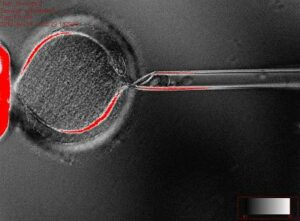
by Tom Strode
The “brave new world” of human cloning apparently has arrived, and critics are waving the warning flags. Oregon-based scientists reported Wednesday, May 15, they had cloned human embryos, reportedly the first successful attempt at such cloning, as a means of producing embryonic stem cells. The researchers extracted stem cells from the clones, destroying the days-old human embryos in the process.
The scientists used basically the same cloning method utilized in 1996 by Scottish researchers to create the first cloned mammal, Dolly the sheep.
News of the successful experiment seemed certain to revive the cloning controversy, which has been dormant in recent years. One of the battlegrounds likely will be in Congress, which could see new efforts to ban human cloning. Those efforts probably will involve debates on the extent of a prohibition — on cloning for reproductive purposes or for both research and reproductive purposes.
Critics — who point out cloning an embryo for experimentation is reproductive by nature because a new human being has been created — criticized the successful research announced in the journal Cell as both unethical and unnecessary. Supporters of the cloning technique sometimes call it “somatic cell nuclear transfer” — which simply is the scientific name for cloning.
“Let’s be clear — what these researchers are doing is creating a cloned human being in order to destroy that human being to harvest its stem cells for the benefit of older and bigger human beings,” Southern Baptist ethicist Richard Land told Baptist Press. “There are words for such activity — barbaric and uncivilized.”
The cloning technique used by scientists at Oregon Health and Science University (OHSU) and the Oregon National Primate Research Center was a version of somatic cell nuclear transfer, the method used to create Dolly. The researchers transferred the nucleus of a cell that contained a person’s DNA into an egg that no longer had its nucleus. After stimulation, some of the embryos developed to a stage where they produced stem cells.
Daniel Sulmasy, a professor of medicine and a bioethicist at the University of Chicago, told National Public Radio (NPR), “This is a case in which one is deliberately setting out to create a human being for the sole purpose of destroying that human being. I’m of the school that thinks that that’s morally wrong no matter how much good could come of it.”
Opponents of cloning and embryonic stem cell research (ESCR), which is lethal for the human embryos, pointed to other stem cell research that has surpassed ESCR in therapies in human beings and is not ethically controversial. Stem cells are the body’s master cells that can develop into other cells and tissues, giving hope for the development of cures for a variety of diseases and other ailments.
Research with adult stem cells in human trials has produced therapies for more than 70 afflictions, including cancer, juvenile diabetes, multiple sclerosis, heart damage, Parkinson’s and sickle cell anemia. Work with induced pluripotent stem (iPS) cells also has shown promise. This technique, first used in 2006, involves reprogramming adult skin cells into stem cells virtually identical to those in human embryos. Research with neither adult nor iPS stem cells involves the destruction of embryos, unlike ESCR.
ESCR — though highly touted because of the capacity of embryonic stem cells to transform into any cell or tissue in the body — has yet to treat any disease in human beings and has been plagued by the development of tumors in lab animals.
Land, president of the Ethics & Religious Liberty Commission, said iPS cells “make the supposed necessity of embryo-destructive research increasingly unnecessary. I am perplexed as to why we continue to pursue such dehumanizing research when morally preferable alternatives are readily available.”
David Prentice, a stem cell expert and a senior fellow at the Family Research Council, said, “Modern science has passed this by…. [T]he entire faulty concept of using the cloning technique has been superseded by uncontroversial techniques.”
Opponents of cloning and ESCR also warned about a potentially nightmarish future now that the human cloning barrier has been broken.
The cloning technology “will open the door to human engineering and a brave — but highly dangerous — new world,” Prentice said in the written statement.
“Given that science has passed cloning by for stem cell production, this announcement seems simply a justification for making clones, and makes reproductive cloning and birth of human clones more likely.”
Sulmasy, a member of President Obama’s Commission for the Study of Bioethical Issues, said, “We already know there are people out there who are itching to be able to be the first to bring a cloned human being to birth. And I think it’s going to happen.”
Shoukhrat Mitalipov, who led the cloning effort by the research team, rejected such fears.
Human cloning “is not our focus, nor do we believe our findings might be used by others to advance the possibility of human reproductive cloning,” Mitalipov said in a written release from OHSU.
There is no federal prohibition on any form of human cloning. The House of Representatives passed legislation to ban cloning for both research and reproductive purposes in 2001 and 2003, but the Senate never voted on a comprehensive ban. Some senators supported the prohibition of cloning to produce a child but not cloning for research.
— Baptist Press www.bpnews.net http://www.bpnews.net/BPnews.asp?ID=40316



